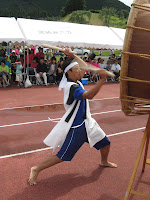I started to write about this last year, but I never got around to completing it. So here goes...
Every year, at some point in the summer, most (all?) schools in Japan hold both a sports festival as well as a culture festival. Some schools have them on separate weekends, but my school has both festivals over a three-day period that always starts on a Saturday and ends on a Monday.
The sports festival isn't too interesting for us teachers, since we primarily only help with set-up, judging, and clean-up. (This year, for whatever reason, I wasn't assigned any duty whatsoever, so I helped out wherever I felt there was a need, which mostly meant I helped clean up at the end of the day. Then again, I was busy taking pictures, anyway!) The kids are the ones who get to have all the fun, since they are the ones competing in the various events.
The one bit of action the teachers do see is when we do the x-by-100 meter relay (x = about 32). I guess that's when we get our 15 seconds of fame. I always hope that I at least get to run the part of the track leading to the finish line, since that's where 90% of the fans (parents) are located. After all, if I have to run, I might as well be seen! The first year I was here, I had to run starting from the finish line, so that was no good. Two years ago and this year, I ran the second leg, which was even worse. Last year was the only cool year, when I indeed got to come down the home stretch and show off my skills. I can still hear the "
hayai(!)s" even today. (
"Hayai" means "fast.")
The kids and teachers are divided equally into two teams, which are of course "red" and "white" (it's the same at every single school in Japan--- how boring!) and two prizes are awarded: one for the team with the best spirit, and one for the team that scores the most points in the actual sporting events. For the most part, the kids get to choose which team to be on, but, as far as I can tell, we teachers are simply assigned to a team.
My first three years here, I was a perfect 3-for-3: red, red, white; win, win, win. This year, to my regret, I was placed on the white team again (red is simply cooler than white). We certainly had the advantage in the cheering department, since the kid who was the white team leader is possibly
the craziest, funniest, goofiest, and(!) wackiest student in the whole school, so the spirit prize was his (ours) to lose. The question was, therefore, whether we had the players to pull off the victory in the athletic department.
Sure enough, the white team won the spirit award, hands down. But who would win the big cheese?
All I knew was, the morning events, which consisted mostly of things like tug-of-war, two variants of capture the flag, "topple the pole," and a tire pull, as well as a few track-and-field events) didn't go so well for the white team. The overwhelming majority of the afternoon events (all track-and-field), however, went the white team's way.
So who would it be? Red or white?
We could hardly believe our ears when the scores were read: "White team -- one thousand ... three hundred ...... nine points." "Red team -- one thousand ... three hundred ...... ten points."
My reaction: "Huh? Say what? Are you kidding me? One point? One point?
One(!) point?"
Basically, all the kids on the white team reacted in the same manner: disbelief.
I can't remember the scores from the previous years, but I'm 99% sure there was a huge margin of victory each time. A one-point victory was certainly a first.
Oddly enough, however, since no one on the white team actually believed we lost, there was no crying as is usually the case on the losing team. As a matter of fact, about the only student I remember seeing cry was the red team leader. Of course, his were happy tears.
 I grew up in San Francisco, where I was pretty spoiled in terms of the weather, since it's rather mild all year. Unfortunately, ever since I moved away in 1986 to go see the world, starting with Germany, I've mostly had to deal with the four seasons (and I'm not talking about the hotel!). Japan is no different from many of my other homes away from home over the years, which primarily means pretty cold winters and hot, humid summers.
I grew up in San Francisco, where I was pretty spoiled in terms of the weather, since it's rather mild all year. Unfortunately, ever since I moved away in 1986 to go see the world, starting with Germany, I've mostly had to deal with the four seasons (and I'm not talking about the hotel!). Japan is no different from many of my other homes away from home over the years, which primarily means pretty cold winters and hot, humid summers.




















